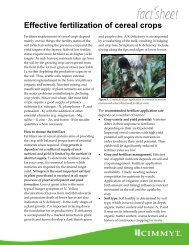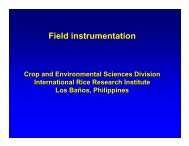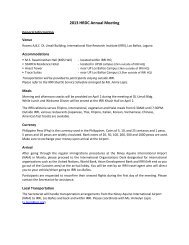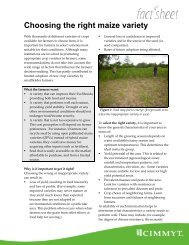Rice Stripe - Rice Knowledge Bank - International Rice Research ...
Rice Stripe - Rice Knowledge Bank - International Rice Research ...
Rice Stripe - Rice Knowledge Bank - International Rice Research ...
You also want an ePaper? Increase the reach of your titles
YUMPU automatically turns print PDFs into web optimized ePapers that Google loves.
Virus<strong>Rice</strong> stripe virus (RSV) is the type member of the genus Tenuivirus. It is filamentous or thread-like, 500–2,000 nm in length, with a diameter of only 3 to 8 nm. The virion consists of four segmentednucleocapsids. These single-stranded RNA segments are the following:RNA 1—8.9 kb, completely negative sense, contains a single open reading frame and encodesRNA-dependent RNA polymerase (Toriyama et al 1994), which is known to be responsible forreplication and transcription of the viral RNA genome.RNA 2—3.5 kb, ambisense, encodes two nonstructural proteins: a membrane-associatedprotein in the viral or positive sense and a putative membrane glycoprotein in the viralcomplementary or negative sense (Takahashi et al 1993).<strong>Rice</strong> <strong>Stripe</strong> – Page 2 of 4rice fact sheetsRNA3—2.7 kb, encodes a nonstructural protein (NS3) that functions as a suppressor of genesilencing in the viral sense and the nucleocapsid protein in the viral complementary sense(Kakutani et al 1991, Xiong et al 2008).RNA4—2.1 kb, encodes two nonstructural proteins: a protein known as a major noncapsidprotein in the viral sense that accumulates in infected plants and may be involved inpathogenesis and a nonstructural protein that functions as a movement protein in the viralcomplementary sense (Toriyama 1986, Kakutani et al 1990, Zhu et al 1992, Xiong et al 2008).RSV does not produce enveloped virions in infected plants (Liang et al 2005).TransmissionThe virus is transmitted in a persistent, circulative-propagative manner mainly by the small brownplanthopper (SBPH), Laodelphax striatellus Fallén. It is also transmitted by three other planthopperspecies, Unkanodes sapporona (Matsumura), U. albifascia (Matsumura), and Terthron albovittatum(Matsumura). The virus is transmitted from female adults to offspring through the eggs. It can betransmitted to about 90% of the offspring for up to 40 successive generations (Lee 1969). The virus canbe transmitted by mechanical inoculation, but with difficulty. It is not transmitted by seeds or by contactbetween plant tissues.The optimum acquisition period is 1 day, but the acquisition period can be as short as 15 minutes. Theincubation period of the virus in L. striatellus is usually 5 to 10 days; however, it can be as long as 21days. Females transmit the virus more efficiently than males. The ability of L. striatellus to transmit thevirus decreases with age (Iida and Shinkai 1969) and after overwintering. However, overwinteredinsects maintain a high transmission rate to their progeny (Iida and Shinkai 1969).The optimum temperature for transmission of the virus is 25–30 °C (Chung 1974).The virus multiplies in the vector and is retained when it molts.Host range and epidemicsRSV infects around 80 species of the family Gramineae and several nongraminaceous species,including wheat, barley, foxtail millet, rye, and oat (Ou 1985, Hibino 1996). RSVD epidemics in someareas have been attributed to the increase in area planted to wheat and barley. Cereals, especiallywheat and barley, are not considered as important reservoirs of the virus but they serve as habitats forthe vector during the rice fallow period (Hibino 1996). After rice is harvested, some of the viruliferousadult vectors migrate to grasses surrounding rice fields or nearby fields and oviposit. Congenitallyinfected nymphs migrate to newly established crops and to weeds and overwinter as fourth-instarnymphs and diapause (Hibino 1996). First-generation adults of this overwintering generation emergeand some move to newly established rice fields. Second-generation adults appear about a month later.First- and second-generation adults feed on rice at seedling and early tillering stages, respectively, andmay cause severe epidemics (Wang et al 2008). On the other hand, the viruliferous vectors can transmitthe disease from rice to newly established seedlings of wheat and barley in winter, causing severeepidemics in these crops as well (Xiong et al 2007).Host-plant resistanceJaponica varieties that are grown in lowland areas are generally susceptible to RSVD, whereas indica,Javanese, and japonica upland varieties have genetic resistance. These resistant upland varieties havegenes with dominant resistance to RSV, Stv-a, and Stv-b (Washio et al 1968). Indica varieties haveStvb-i, which is allelic with Stv-b. Varieties that are currently grown by farmers have only the Stvb-i gene(Nemoto et al 1994), which has remained resistant to RSV since the 1960s (Maeda et al 2006).For more information, visit the <strong>Rice</strong> <strong>Knowledge</strong> <strong>Bank</strong>: http://www.knowledgebank.irri.orgDeveloped with input from: N. P. Castilla, S. Savary, A. Sparks and I. R. Choi2Produced by the <strong>International</strong> <strong>Rice</strong> <strong>Research</strong> Institute (IRRI) • © 2012, IRRI, All rights reserved • Feb 2012


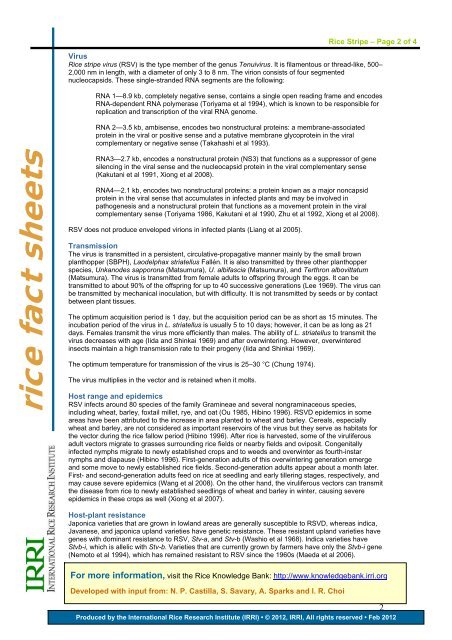

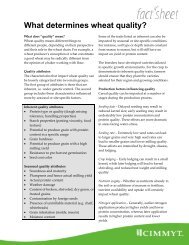


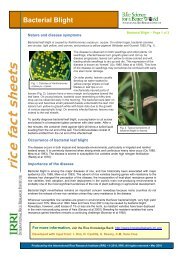

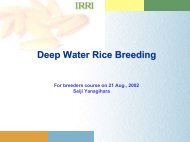
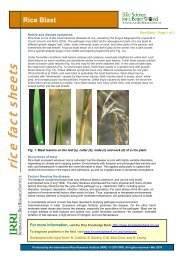
![International Standards' Organization â Rice Specification [ISO 7301]](https://img.yumpu.com/36696862/1/190x245/international-standards-organization-a-rice-specification-iso-7301.jpg?quality=85)

